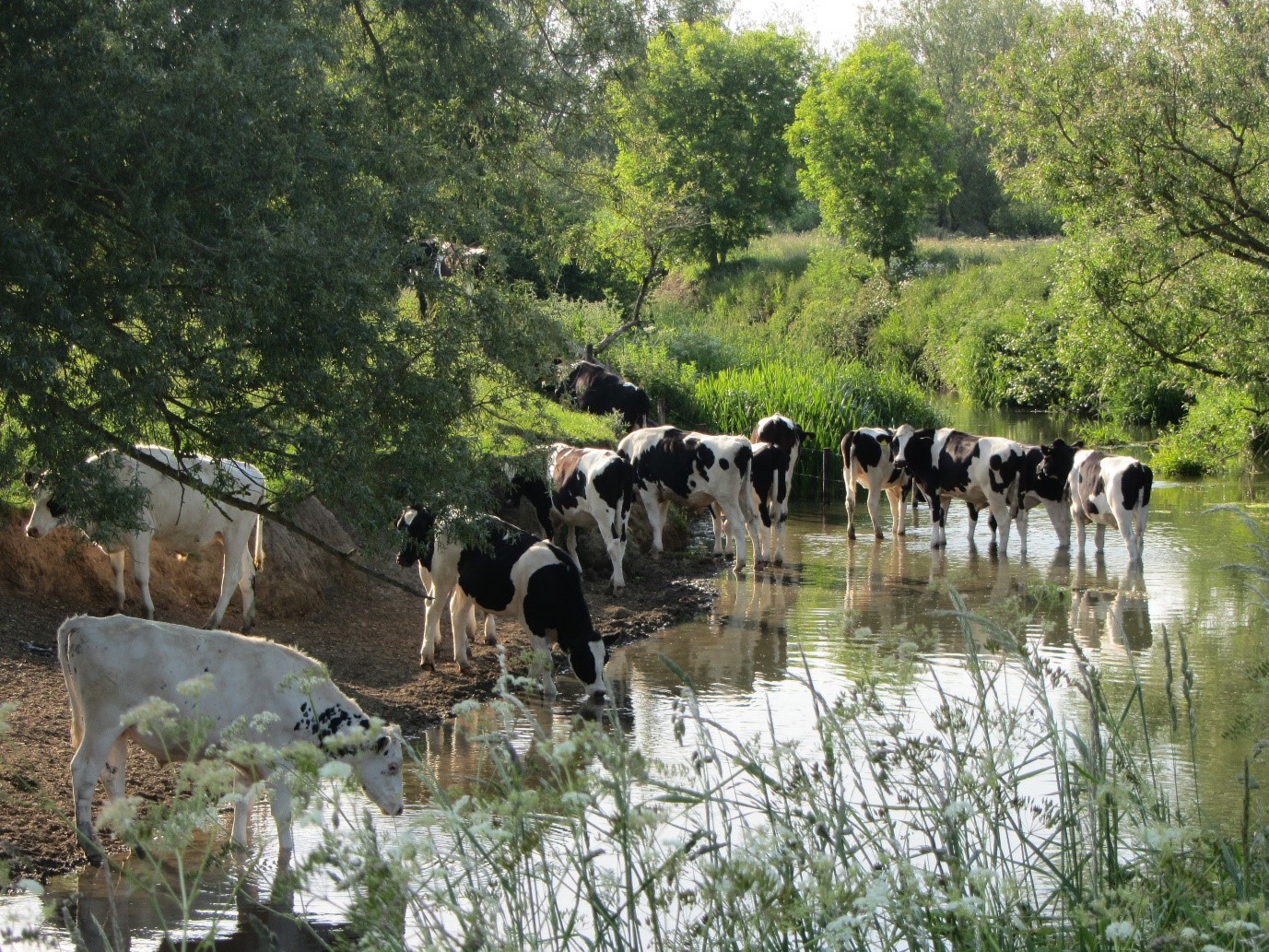
(Image © Dr Mark Everard)
Cattle serenely sipping water from a river’s edge are often depicted in landscape art or magazine illustrations as a form of pastoral idyll. In former times, before the massive population boom of the latter half of the twentieth century (the world population has tripled in six decades) and unprecedented intensification of agriculture, this may have been a sustainable vision. However, the impacts of trampling of river margins by high stock densities of modern breeds of cattle such as Holstein Friesians, the world’s highest-production dairy animals that typically approach 600kg in weight, are anything but benign to the ecology of river systems.
The impacts of intensive cattle trampling – the term ‘poaching’ is used in the UK to describe the cutting up of riparian zones by the feet of stock animals – on rivers and water resources are numerous. They include degradation or complete removal of marginal vegetation that naturally combats erosion, liquefaction of soil which enters rivers with its associated loads of nutrient, agrochemical and other substances, as well as direct defaecation into the water and on the bank with its associated loads of organic matter, potentially problematic bacteria and other microorganisms, and residues of veterinary medicines. Sediment particles released into the water can be carried by river flows for some distance, settling on the bed to block pores in gravels directly depriving river invertebrates of habitat, stifling water plants, as well as creating a hard layer inhibiting the spawning of many species of fish and deoxygenating the river bed which kills those eggs that have been laid.
Were a factory responsible for the scale of impact on a river system as great as that inflicted on river margins daily by large herds of watering cattle the length and breadth of the country, it would be faced with prosecution and severe penalties. But somewhere buried in the British psyche is that this is acceptable, even an iconic image of rural idyll, so the scale of impact goes largely uncontrolled other than through meagre and barely enforced ‘best practice’ guidelines and, supposedly, ‘cross compliance’ preconditions for receiving subsidies. Impacts on water bills necessary to fund the cleaning up of more contaminated water are one of many far from negligible societal impacts that is generally far from broadly appreciated under current fragmented policy and market regimes.
The measurement of impacts arising from routine riparian cattle trampling in an anonymised river edge in south west England was the subject of a paper arising from an MSc research project undertaken by UWE/IWSN scholar Jennifer Wilson. The full reference is:
- Wilson, J.L. and Everard, M. (2017). Real-time consequences of riparian cattle trampling for mobilisation of sediment, nutrients and bacteria in a British lowland river. International Journal of River Basin Management, ONLINE, pp. 1-37. https://doi.org/10.1080/15715124.2017.1402778.
The research addressed a knowledge gap stemming from the paucity of prior research correlating a generation of pollutants with cattle activity locally and in ‘real time’. Turbidity, soluble reactive phosphorus and faecal coliforms were analysed at upstream control and downstream impact sites correlated with cattle activity over a 65m river margin throughout a two-month summer period. Riparian cattle trampling impacted water quality, specifically turbidity and faecal coliform levels. Average turbidity increased by more than 90% between upstream and downstream sites during cattle activity, whilst average faecal coliform counts almost doubled. Findings for phosphorus concentrations were less conclusive, perhaps due to filtration of suspended sediment-bound phosphorus prior to analysis.
Farming is of course not only an entirely legitimate but also a necessary activity. However, better understanding of the impacts of practices such as uncontrolled access to the river’s edge and ensuing heavy trampling at contemporary stocking densities and animal sizes does require attention. One solution is fencing the river edge – ‘buffer zoning’ – allowing cattle access to water via piped tanks, foot-operated pumps or in confined access points only. Buffer zoning is cheap but effective, protecting the river and enabling natural regeneration of riparian vegetation that provides habitat for wildlife including fish nursery areas, attenuates pollutants running overland after heavy rainfall, improves in-stream water purification processes, averts erosion, buffers flows to avert flood damage and retain water during drought conditions, and improves landscape aesthetics amongst a wide range of other publicly beneficially ecosystem services.
Illustrative cost–benefit assessment of potential buffer zone installation to exclude cattle from the river margin at the study site was also considered within this research. Based on values transferred from another relevant published study, it was concluded that investment in a buffer zone would achieve a benefit-to-cost ratio of approximately 38:1 with a distribution of broad societal benefits to the farmer, local people and wider publics.
This research sheds more light on the gap in current economic and regulatory systems – rewarding practices that penalise and increase costs for other river and water users – that could be remedied in policy reform. This may include such ‘common sense’ measures as diverting public subsidies towards buffer zoning that, on the basis of the illustrative cost-benefit assessment, would pay back to taxpayers through multiple publicly beneficial ecosystem services by preventing damage to vital water resources.
